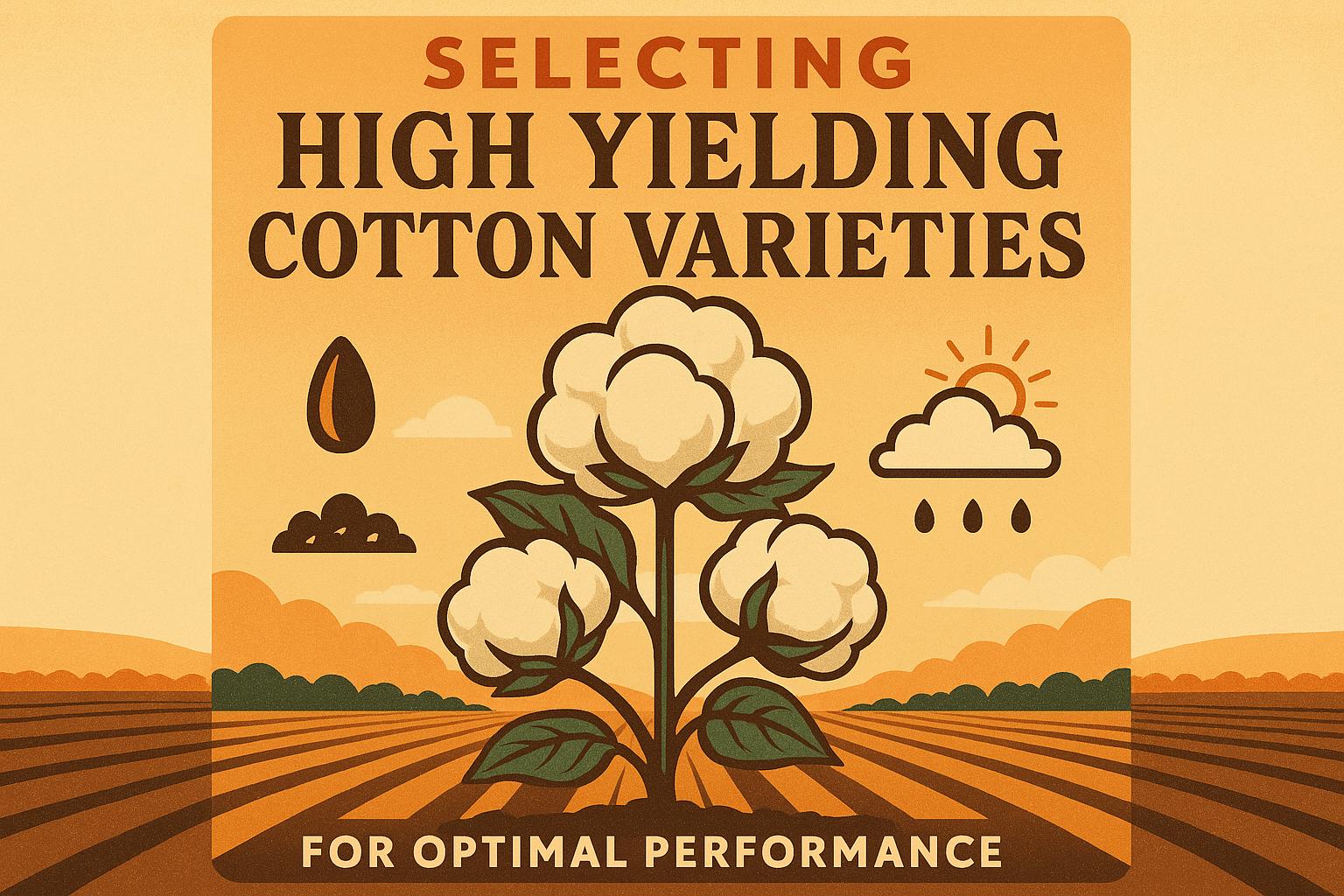Efficient cotton export logistics are critical to ensuring timely deliveries, maintaining product quality, and accessing premium markets. Poor planning can lead to costly delays, missed opportunities, and damaged goods. Here's a quick breakdown of what you need to know:
- Inland Transport: Trucks are ideal for short distances, while rail is more cost-effective for longer hauls. Intermodal hubs streamline the transition between these methods.
- Port Selection: Ports like Houston, Savannah, and Long Beach offer different advantages based on location, capacity, and shipping routes.
- Ocean Freight: Choose reliable carriers and negotiate competitive rates. Stay updated on shipping schedules to avoid disruptions.
- Documentation: Accurate paperwork, including USDA inspection certificates and customs filings, is essential to keep shipments moving.
- Risk Management: Plan for potential disruptions like port congestion or labor shortages by building buffer time into schedules and diversifying transport options.
Trade Terms 101: Incoterms Made Simple: A Beginner’s Guide to Importing & Exporting
From Cotton Gin to Export Hub: The Logistics Network
Getting cotton from rural ginning facilities to international export ports is no small feat. It’s a process that requires careful coordination across various transportation methods, with routes often spanning hundreds or even thousands of miles. Every step, from gin to ship, hinges on precise planning to keep things running smoothly.
Inland Transportation Methods
For the first leg of the journey, trucks are the go-to option. Their flexibility makes them indispensable for moving cotton bales from gins to rail terminals or directly to port facilities, especially in remote areas where rail access is limited. However, when the distances stretch further, rail transport becomes the more cost-effective choice.
Take Brazil as an example. About 80% of its cotton exports rely on trucks to reach the ports. These truck trips, often covering vast distances, can take up to five days. But for longer hauls, rail transport steps in to cut costs. In Brazil’s Mato Grosso region, cotton travels an impressive 2,100 km (about 1,300 miles) to the Port of Santos. Instead of trucking the entire distance, bales are first moved by truck to rail terminals, where they’re loaded into containers for a 1,400 km (roughly 870 miles) rail journey from Rondonópolis to the port. This intermodal strategy handles an incredible 13,400 containers annually from this region alone.
"Cotton arrives at the railway terminal in bales transported by truck. Then, it is loaded into the containers in an operation known as 'stuffing' (i.e., loading bales into containers). Annually, 13,400 containers are transported from Mato Grosso to the Port of Santos." - Andrea Ramos, Commercial Director, Brado Logística
In the U.S., the choice of transportation often depends on distance. Cotton from Texas and Oklahoma typically travels shorter routes to Gulf Coast ports, making direct trucking a practical option. But for cotton grown in states like North Carolina or Georgia, longer distances to major export hubs make rail transport a more attractive solution.
This combination of trucking and rail ensures efficient movement from ginning facilities to intermodal hubs, keeping the supply chain flowing.
The Role of Cotton Gins in the Export Process
Cotton gins play a vital role as the starting point in the export logistics chain. These facilities don’t just separate fibers from seeds - they also compress cotton into standardized bales, wrap them for protection, and coordinate with transportation providers to ensure seamless transitions to the next stage.
The location of gins can significantly impact costs and delivery schedules. For example, in Australia, the Katherine gin was strategically built to process cotton locally, cutting down on the high logistics costs of transporting raw cotton long distances.
"The gin is a great boost for the cotton industry in the Territory. While overall the number of cotton growers in the NT is still growing, this means no longer do they need to transport their modules thousands of kilometres to gins in Queensland." - Adam Kay, Chief Executive Officer, Cotton Australia
In the U.S., having gins near key production areas is equally important. Tools like cottongins.org help logistics planners identify ginning facilities that minimize transportation distances to export hubs, keeping costs competitive.
However, ginning capacity and timing can also pose challenges. During peak harvest seasons, bottlenecks at gins can delay bale production, throwing off shipping schedules. To avoid disruptions, exporters often collaborate with multiple gins, ensuring a steady supply and backup options when one facility reaches capacity.
Intermodal Hubs and Regional Concentration
Once cotton is processed at the gin, intermodal hubs take over to streamline the journey to export ports. These hubs consolidate smaller truck shipments into full rail containers, improving cost efficiency and simplifying logistics.
Brazil’s Brado Logística offers a great example of how intermodal networks operate. With 11 intermodal terminals connecting agricultural regions to ports, Brado ensures a smooth transition from truck to rail, making long-distance transport more economical.
In the U.S., regional production patterns heavily influence where intermodal hubs are placed. High-production areas like Texas’s High Plains or the Mississippi Delta have larger hubs capable of handling significant cotton volumes. These hubs benefit from frequent rail service and better rates, thanks to consistent shipment flows.
For distances over 500 miles, rail transport becomes a game-changer. It’s typically 30–50% cheaper than trucking for long hauls, but this advantage hinges on consolidating enough volume to fill containers and align with rail schedules. Intermodal hubs make this possible by aggregating cotton from multiple sources.
Timing is critical in this process. Cotton bales need to arrive at intermodal terminals in sync with container availability and rail departure schedules. A delay at any stage - whether at the gin, during trucking, or at the terminal - can ripple through the system, potentially causing missed shipping deadlines at export ports.
Infrastructure investments continue to play a key role in improving intermodal capabilities. Expanding railway networks in major cotton-growing regions helps reduce reliance on long-haul trucking, making U.S. cotton exports even more competitive.
Ocean Carrier Selection and Freight Rates
Once your inland and intermodal logistics are in place, the next step is to select an ocean carrier that ensures reliable and affordable international shipping. This choice plays a critical role in completing the export process efficiently. Look for carriers known for their dependability and responsive customer support.
To gauge a carrier's reputation, check online reviews and endorsements. Additionally, stay in close contact with your freight forwarder to receive timely updates on shipping schedules and other essential details.
sbb-itb-0e617ca
Regulatory Compliance and Export Documentation
Navigating U.S. Customs and USDA regulations is a critical step to ensure smooth cotton exports. Here’s a breakdown of the key requirements:
Customs and USDA Inspection Requirements
Exporters must file Electronic Export Information (EEI) through the Automated Export System (AES) for most cotton shipments. This filing, required by U.S. Customs and Border Protection, typically needs to be completed at least 72 hours before the vessel departs. The EEI includes detailed shipment data, which is essential for compliance.
On the USDA side, exported cotton undergoes a classification process to ensure it meets quality standards. Cotton samples are assessed against specific quality criteria, and the resulting classification is included in export documentation. This step is vital for international buyers, as it confirms the product’s quality.
Customs officials may also inspect containers, either randomly or based on risk factors, to ensure shipments follow export regulations. Proper and thorough documentation can help reduce the chances of delays during these inspections.
Managing Risks and Costs in Cotton Export Logistics
Export logistics for cotton are fraught with potential disruptions at every turn. From port congestion to inland delays, these challenges can significantly impact profitability. Let’s delve into some common issues and explore strategies to manage both risks and costs effectively.
Common Disruptions and How to Handle Them
One of the most pressing issues for cotton exporters is port congestion. This problem arises from a mix of factors, including sudden spikes in demand, outdated infrastructure, geopolitical tensions, and labor shortages. The result? Lengthy delays that ripple through the entire supply chain.
Take the Red Sea crisis, for example. During this geopolitical upheaval, shipping routes were drastically altered. Commercial vessels had to bypass the Red Sea and reroute around the Cape of Good Hope. This detour not only increased vessel traffic in the region by 75% but also added an average of 14 days to transit times. These delays translated into higher costs and disrupted delivery schedules.
Another significant challenge is labor disruptions, such as strikes or workforce shortages. In the first half of 2024, for instance, these issues, coupled with rising operational expenses, led to a sharp increase in global shipping costs.
Then there are blank sailings, where ocean carriers cancel scheduled departures due to low demand or operational hurdles. These cancellations leave exporters scrambling to find alternatives, often at higher costs. To navigate this uncertainty, many exporters establish relationships with multiple carriers to ensure they have backup options.
Inland operations aren’t immune to setbacks either. Bottlenecks in transportation and logistics further compound delays, emphasizing how interconnected and fragile the supply chain can be.
To tackle these challenges, cotton exporters often adopt proactive measures like building extra buffer time into their shipping schedules and diversifying their operational strategies. These steps help cushion the impact of unexpected disruptions.
Building a Resilient Supply Chain
Beyond addressing immediate disruptions, creating a resilient supply chain is key to long-term stability. Cotton exporters are increasingly focusing on strategies to absorb shocks and minimize risks. Diversifying shipping routes is one such approach, spreading risk across multiple pathways. Maintaining a strategic inventory level also helps producers stay flexible, ensuring they can meet deadlines even when delays occur.
Conclusion and Key Takeaways
To excel in cotton export logistics, you need to fine-tune every aspect of your supply chain. As we've discussed, a well-structured logistics strategy ties together processing, transportation, and compliance to strengthen your export operations.
Each transportation method brings unique benefits depending on the route's distance and destination. By optimizing inland transport, you set the stage for smarter port decisions.
Choosing the right port can significantly influence your costs and efficiency. Major U.S. export hubs like Houston, Savannah, and Long Beach each offer distinct advantages, including diverse shipping routes, specialized handling capabilities, and competitive freight rates. However, while efficient transport is essential, ensuring compliance with regulations is what keeps shipments moving smoothly.
Documentation is another cornerstone of export success. Essential paperwork - such as commercial invoices, bills of lading, USDA inspection certificates, and export licenses - must be complete and accurate. Missing or incorrect documents can lead to costly delays or even shipment rejections.
Recent disruptions and port congestion highlight the need for resilience in your supply chain. Building relationships with multiple carriers, maintaining strategic inventory levels, and adding buffer time to shipping schedules can help you navigate unexpected challenges.
When it comes to managing costs, a big-picture approach is critical. Instead of focusing solely on freight rates, consider the total landed cost. This includes inland transport, port fees, documentation expenses, and potential delay costs. Paying slightly higher rates for reliable service can often lead to better profitability in the long run.
For cotton producers aiming to refine their export operations, start by mapping out your current logistics network and identifying bottlenecks. Resources like cottongins.org can help you locate processing facilities that align with your strategy. Strengthen relationships with logistics providers, stay up-to-date on regulatory changes, and keep a close eye on market trends that could impact your shipping decisions.
While challenges like geopolitical tensions, infrastructure limitations, and shifting trade regulations persist, producers who understand the logistics basics and build flexible, resilient supply chains will be better prepared to meet global cotton demand. By mastering these logistics essentials, you can create an export operation that thrives in a competitive global market.
FAQs
What should I consider when deciding between truck and rail for cotton exports?
When choosing between truck and rail transport for cotton exports, key considerations include cost, distance, and shipment size. Rail is typically a better option for moving large, bulk shipments over long distances. It’s more fuel-efficient and can significantly reduce transportation costs when dealing with high volumes across extended routes.
Trucks, however, offer greater flexibility and faster delivery for shorter distances or smaller loads. They’re also ideal for time-sensitive shipments, thanks to quicker loading and unloading processes.
The best choice ultimately depends on your shipment's size, the route's length, and how urgently the delivery is required.
What steps can cotton exporters take to manage risks like port congestion and labor disruptions?
To manage risks like port congestion and labor disruptions, cotton exporters should focus on strategies that reduce potential delays. One effective approach is to build up inventory and secure essential supplies in advance of any expected disruptions. Exploring alternative shipping routes and using different ports can also help keep operations running smoothly.
Keeping up-to-date with labor negotiations and supply chain updates at major U.S. export ports is equally important. Working closely with supply chain partners and developing contingency plans can provide the flexibility needed to handle unforeseen challenges. By staying ready and adaptable, exporters can better manage logistical risks and safeguard their operations.
What documents are required to meet U.S. Customs and USDA regulations for exporting cotton?
When exporting cotton, having the right paperwork is crucial to meet U.S. Customs and USDA requirements. One of the key documents you'll need is a Phytosanitary Certificate, which confirms that the cotton complies with plant health standards and is free from pests or diseases. You'll also need certifications approved by the USDA that verify the cotton's quality, which typically involves specific testing procedures.
On top of that, ensure you complete all export declarations and include any necessary quota or tariff documents to make the customs process smoother. Getting these documents in order not only helps avoid delays but also ensures you stay in line with all export regulations.


